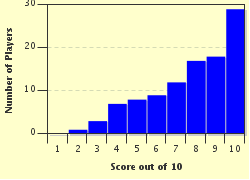Quiz Answer Key and Fun Facts
1. The host for the 6th Annual Academy Awards Ceremony was a man who became known as Oklahoma's favorite son, and once ran a mock campaign for the 1928 presidential race. Who was he?
2. With this installment of the Oscars, the eligibility for films to be considered altered from an August - July time frame to coincide with the calendar year. It remained that way for the remainder of the 20th century.
3. Who was the second British actor to take home the Oscar for Best Actor, winning for his portrayal of King Henry VIII?
4. The Oscar for Best Actress went to the lady who played Eva Lovelace in "Morning Glory" (1933). Who took home her first of eventually four Best Actress Oscars?
5. Meg, Jo, Beth and Amy...if you recognize these names, then you will know what film won the Academy Award for Best Adapted Screenplay. And the Oscar went to... which movie?
6. The Oscar for Best Story went to a tale of romance between a terminally-ill woman and an escaped murderer who is sentenced to hang for his crime. Written by Robert Lord, what film won the award?
7. Ernest Hemingway penned the novel on which the winning film for Best Cinematography was based. What film (and cinematographer) won?
8. A new category was introduced at the 6th Academy Awards, that only appeared at the ceremony until 1938 (10th Oscars). This year there were 18 nominees and seven winners! What was the name of the category?
9. When the Oscars host announced the winner of the award for Best Director, he just said, "Come up and get it, Frank!" The winner was Frank Lloyd, for "Cavalcade" (1933), but who ran up to receive the Oscar, thinking he had won for "Lady for a Day" (1933)?
10. A 33-year span of time is covered in the film that won Best Picture this year, its backdrop including references to the Second Boer War, the passing of Queen Victoria, the sinking of the Titanic, and World War I. And the Oscar went to... what film?
Source: Author
reedy
This quiz was reviewed by FunTrivia editor
skunkee before going online.
Any errors found in FunTrivia content are routinely corrected through our feedback system.


